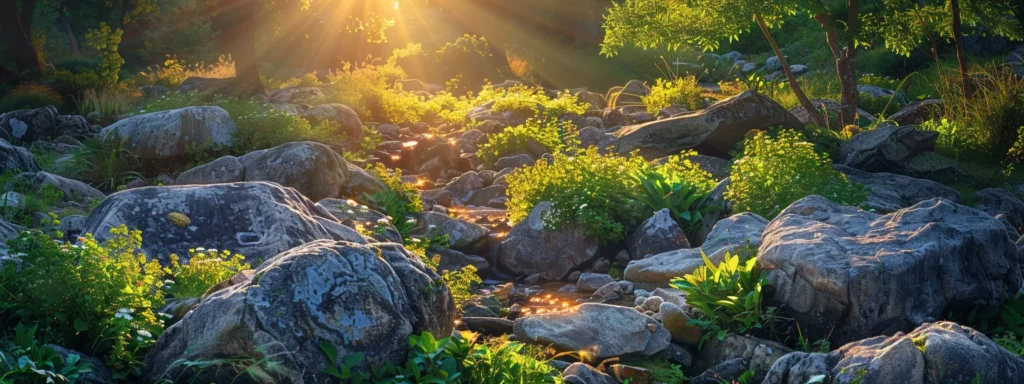
What Makes Stone Landscaping Stand Out?
Are you tired of traditional landscaping options that don’t offer the durability and beauty you desire? Stone landscaping stands out as an excellent choice, providing both strength and aesthetic appeal. This article will explore what makes stone landscaping unique compared to other materials and offer best practices for implementation. By reading on, you’ll learn how to enhance your outdoor space while addressing common issues with maintenance and style, ensuring your landscape remains attractive and functional for years to come.
What Makes Stone Landscaping Unique Compared to Other Materials?
Stone landscaping offers a unique combination of aesthetic appeal, durability, and versatility unmatched by other materials. In examining the visual charm of stone, you’ll see how it transforms spaces while withstanding summer heat and pressure. Its environmental benefits help combat erosion, especially during drought conditions. Maintenance needs for stone are also lower compared to alternatives like cement, making it a practical choice for diverse landscape designs.
Examine the Aesthetic Appeal of Stone in Landscaping
When considering stone landscaping, you will appreciate its ability to enhance visual appeal across various outdoor elements, such as patios, fences, and roofs. Stone provides a natural, rustic look that complements any landscape design, creating an inviting atmosphere. Additionally, the rich textures and colors of stones allow for endless design possibilities, enabling you to craft unique spaces that reflect your style and preferences.
Using stone in your landscaping not only beautifies your environment but also integrates seamlessly with horticulture. With proper placement, stone effectively retains moisture, reducing the need for excessive fertilizer while promoting healthy plant growth. This functional beauty makes stone an ideal choice for homeowners and landscapers alike, enhancing aesthetics while providing practical benefits.
Evaluate the Durability of Stone Compared to Alternative Options
When you evaluate the durability of stone landscaping, it becomes clear that stone outlasts many alternative materials. Unlike metal or wood, which can corrode or rot over time, stone remains resilient against weather elements and wear. Stone patios, for instance, can endure heavy foot traffic without significant damage, providing a long-lasting investment for your outdoor space.
Additionally, when incorporating stone veneer into your landscaping, you ensure a sturdy solution that requires minimal maintenance. The use of mortar helps bond these stone elements securely, further enhancing their longevity. This durability not only means fewer replacements but also reduces the need for extensive irrigation systems, as stones can naturally aid in moisture retention, benefiting surrounding plants and saving resources.
Investigate the Versatility of Stone for Various Landscape Designs
When considering stone for your landscaping, its versatility is unmatched, particularly in creating functional spaces. Utilizing pavers made from natural stone allows you to design pathways and patios that are aesthetically pleasing and incredibly durable. The adaptability of stone means it can be used effectively in various applications, enhancing both the visual appeal and practicality of your outdoor areas whether you’re arranging seating around a fire pit or incorporating it as a base for potting soil in garden beds.
Moreover, stone stands out as an excellent choice in regions prone to wildfire, as its natural properties can help mitigate risks associated with flames and embers. By incorporating proper stone features, you can design landscapes that protect surrounding flora while providing an appealing look. This functional use of stone makes it an ideal material for creating safe, inviting outdoor spaces that align with your landscaping goals.
Consider the Environmental Benefits of Stone Landscapes
Incorporating stone into your landscape design offers notable environmental benefits that enhance both beauty and functionality. Stone elements, such as retaining walls, play a crucial role in controlling soilerosion and managing water runoff. Additionally, these features help maintain moisture, creating a conducive environment for perennials while minimizing the need for excessive irrigation, which is especially beneficial during dry spells.
Furthermore, stone landscaping aids in weed control, reducing the need for chemical treatments that can harm local ecosystems. By using stones around your garden beds, you create a natural barrier that discourages weed growth and limits dust accumulation around your property. This approach not only supports a healthier landscape but also allows you to enjoy an attractive outdoor space that aligns with environmentally responsible practices.
Analyze Maintenance Requirements for Stone Versus Other Materials
When you compare the maintenance requirements of stone to clay or other materials, you’ll find that stone requires significantly less upkeep. Unlike clay, which can shrink or crack due to moisture changes, stone remains stable and maintains its structure over time. Regular brushing to remove debris is often all that’s necessary to keep stone walls and surfaces looking pristine, while alternative materials may need frequent sealing or replacement to address wear and tear.
Additionally, stone landscaping benefits the ecology of your outdoor space by promoting lower maintenance needs. Because stone helps with moisture retention and minimizes weed growth, you spend less time managing invasive plants. This not only saves you effort but also allows you to focus on enhancing the overall look of your outdoor area, whether by adjusting the height of your stone wall or incorporating new design elements around it.
Now that you’ve seen what sets stone landscaping apart, it’s clear that the right approach can transform your space. Let’s explore the best practices to make your stone landscaping as effective as it is beautiful.
Best Practices for Implementing Stone Landscaping Effectively
To maximize the impact of your stone landscaping, it’s essential to identify suitable types of stone for your projects, such as gravel or pinemulch. Focus on techniques for proper installation to ensure durability and functionality, along with implementing effective drainage solutions to manage water runoff. Maintenance tips will help preserve your stone features in prime condition, complemented by case studies showcasing successful designs to inspire your landscape transformation.
Identify Suitable Types of Stone for Different Landscaping Projects
When selecting stone for your landscaping projects, consider factors such as durability, style, and functionality. For pathways and patios, natural stone pavers offer an attractive appearance and resilience under heavy foot traffic. If you need a sturdy base for garden beds, crushed stone or gravel not only enhances drainage but also minimizes weeds, reducing the amount of time you spend managing your landscape.
Environmental conditions should also guide your choice of stone. In regions prone to weather extremes, such as heavy rains or drought, selecting stones with high moisture retention can create a stable environment for your plants. For projects incorporating features like fire pits or retaining walls, materials like flagstone or granite provide both strength and visual appeal, ensuring that your landscape stands out while meeting practical needs.
Outline Techniques for Proper Installation of Stone Elements
When installing stone elements, it’s crucial to start with a well-prepared base to ensure longevity and stability. Begin by removing any debris, and then grade the area to create a level foundation. Incorporate a layer of sand or gravel, such as peagravel, which helps provide drainage while preventing shifting. This preparation supports your soil‘s nutrient balance and allows plants, like shrubs, to thrive in their new environment.
As you place the stone, ensure that each piece is securely fitted together for a seamless look. Pay attention to the joints, as these areas can collect leaves and debris over time, leading to maintenance issues. Using landscape fabric beneath your stones can help, as it prevents weed growth while allowing water to reach the soil. This approach not only simplifies maintenance but also promotes a healthier landscape by keeping nutrients available for your plants.
Discuss Proper Drainage Solutions for Stone Landscapes
To ensure your stone landscape thrives, it is essential to implement effective drainage solutions. Consider using landscape fabric as a base beneath your stones, which will facilitate proper water flow while preventing unwanted weeds. This layer not only aids in maintaining moisture during a plant’s dormancy but also helps protect the root system from standing water that could lead to disease.
Incorporating drip irrigation can also be beneficial for managing water distribution in your stone landscaping. This method delivers water directly to the roots of your plants, ensuring they receive adequate hydration without oversaturating the soil. By focusing on these drainage strategies, you can enhance the health of your landscape, promoting robust growth and reducing the risk of potential diseases.
Highlight Maintenance Tips for Long-Lasting Stone Features
To maintain your stone features throughout the growing season, focus on regular attention to the surrounding landscape. Ensure that you prune any nearby plants to prevent them from encroaching onto the stone area, which can lead to unsightly growth and damage. Additionally, incorporating organic matter around your stone installations not only enhances the overall aesthetic but also enriches the soil, promoting healthier plant growth.
Pay close attention to the geometry of your stone layout, as this can impact drainage and maintenance needs. A well-thought-out design will minimize the chances of weeds growing between stones, which can detract from the beauty of your landscape. By dedicating time to these maintenance practices, you can ensure that your stone landscaping remains inviting and functional for years to come.
Share Case Studies Showcasing Successful Stone Landscape Designs
One notable case study showcases a residential project where natural stone was used to create a stunning canopy over an outdoor seating area. This design not only provided shade but also enhanced the overall aesthetics of the space. By incorporating moisture-retaining sand and strategically placed plants, the homeowner could nurture seed growth and maintain a lush environment, demonstrating the seamless blend of form and function that stone landscaping offers.
Another example involves a community garden where stone pathways were laid to improve accessibility and create a beautiful visual flow. The combination of various stone types allowed for effective drainage and moisture retention in the soil, promoting a healthier ecosystem for diverse plants. This successful implementation of stone in landscaping not only increased the garden’s appeal but also set a standard for sustainable practices, inspiring others to consider stone as a primary material for their outdoor designs.
Why Stone Landscaping Is the Best Choice for Your Outdoor Space
Stone landscaping stands out due to its unique combination of aesthetic appeal, durability, and versatility. It enhances outdoor spaces while providing practical benefits, such as moisture retention and erosion control. The low maintenance requirements further make stone an attractive choice for homeowners and landscapers alike. By choosing stone, you invest in a sustainable and beautiful landscape that elevates your property for years to come.


